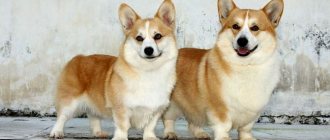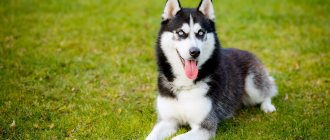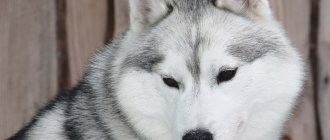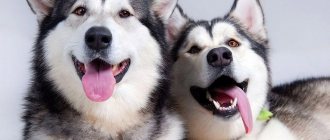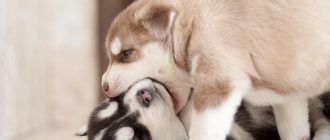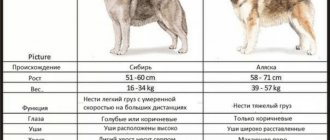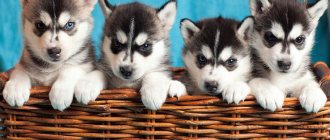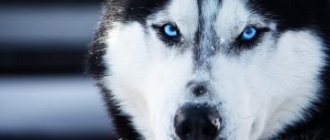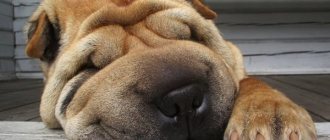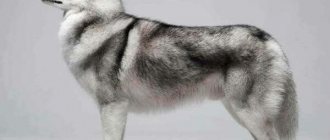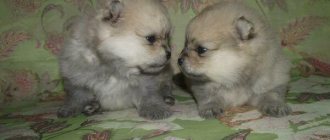Huskies are powerful, athletic dogs that are suitable for active people. When getting a puppy of this breed, you should be prepared for the fact that the baby will turn into a hurricane if he is not raised and given proper exercise. However, the undoubted advantage of keeping huskies is their unpretentiousness.
Caring for this dog includes brushing during shedding and proper nutrition.
Characteristics of puppies
Each puppy is unique, but breeders conditionally divide all puppies into three classes:
- Pet class - puppies without pedigree; have any non-critical defects that exclude their participation in exhibitions.
- Breeding class - puppies of this class will be allowed for breeding in the future; representatives that meet all breed standards.
- Show class - puppies of titled parents with excellent pedigree that meet all breed standards.
Newborns
As a rule, newborn Siberian Huskies weigh from 350 to 500 g. Weight varies depending on the number of puppies in the litter, as well as the gender of the newborn.
In appearance, newborn huskies are no fundamentally different from most newborns of other breeds.
The eyes are closed, the paws are thick, the coat is predominantly white, but with distinctive spots of various colors. It is somewhat more interesting to observe the development of the puppy further, month by month:
- 1 month . Already 15 days after birth, the weight of babies increases more than three times. They are actively developing and by the end of the month reach up to 24 cm at the withers, and up to 3700 g in weight.
- 2 months . By this period of a husky’s life, it is already perfectly built and moves well. The ears begin to rise. He gains weight well, on average 7500 g with a height of 32 cm.
- 3 months . A transfer is made to five meals a day, as a result of which the pet’s accelerated growth rate continues. Height at the withers is about 40 cm.
- 4 months . The transition to adolescence occurs, the features of an adult dog begin to emerge, all this happens simultaneously with rapid growth in height (46 cm) and weight gain, the husky already weighs 18 kg.
- 5 months . Lines continue to form. Gains weight up to 23 kg and height up to 50 cm.
- 6 months . Already a large (under 25 kg) and tall dog (height at the withers is about 54 cm). But still, he is still far from becoming an adult.
- 7 months . There are even fewer distinctive features from an adult representative of the breed. He gains an average of about 3 kg in weight, and may not gain any height at all.
- 8 months . Sexually mature individual. Growth is slowing down. Weight is approaching 30 kg, and height can reach 58 cm.
- 9 months . The height at the withers is 58 cm - this is the height of an adult dog. Weight can reach 33 kg.
- 10 months . With proper care and proper care, by the age of ten months a husky puppy will gain 35 kg, which is the average norm for an adult. It no longer grows in height.
- 1 year . The weight of a male dog can increase up to 40 kg due to accompanying factors. Can grow up to 60 cm in height (but unlikely unless it reaches this mark at 10 months).
Table of weight, height and size by month
| Husky puppy age by months | boy (cm) | Girl (cm) | Weight, kg | ||
| Height at withers | On the back | Height at withers | On the back | ||
| 1 month | — | — | 2,7 | ||
| 2 months | 32 | 30 | 5,9 | ||
| 3 months | 42 | 40 | 10,5 | ||
| 4 months | 484 | 50 | 47 | 50 | 14,3 |
| 5 months | 53 | 54 | 51 | 52,5 | 19,5 |
| 6 months | 55 | 57 | 53 | 54 | 21,5 |
| 7 months | 57 | 58 | 55 | 55 | 24,3 |
| 8 months | 58 | 59,5 | 56 | 56,5 | 25,5 |
| 9 months | 59 | 60 | 57 | 57,5 | 26,5 |
| 12 months | 60 | 62 | 58 | 59 | 28 |
IMPORTANT! The data presented in the table has an average value. Small deviations from these values are allowed.
When do puppies' eyes open?
It happens differently for each puppy; it is impossible to predict the date of opening of the eyes down to the minute. In a properly developing dog, the eyes open 11–16 days after birth. Only one or half of both may open, maybe both entirely. It will take a few more days for the baby to be able to see fully, like an adult dog. If a month has already passed since birth and the eyes are not open, you should contact a veterinarian.
REFERENCE. Two weeks after birth, the puppy can be helped to open its eyes with boiled water.
When does eye color change?
Most Huskies are born with blue eyes, but within six months some of them may change eye color. The Husky breed is also characterized by odd eyes.
To what age do they grow?
The Husky is a large dog, and like most large dogs, it takes a long time to develop. From birth to six months, development in boys and girls is almost identical, after which some differences arise.
- Girls . The phase of active development is up to 8 months, growth continues up to 1 year and is finally formed by 2 years.
- Boys . They actively grow up to 9 months, development occurs up to 1.5 years, and formation occurs up to 2.3 years.
When do teeth change?
They are born without teeth and develop a full set of milk teeth by three months. Then the milk ones begin to gradually fall out and permanent ones appear in their place, this happens until the seventh month. By the ninth month, the puppy should have all 42 permanent teeth.
Husky weight table by month
Below is a table of weights by month for representatives of the breed. Average indicators are given - a small deviation (within 10%) from them, either upward or downward, is acceptable.
| Age (months): | Weight (kg): |
| 1 | 3 |
| 2 | 5-6 |
| 3 | 10-12 |
| 4 | 12-15 |
| 5 | 13-18 |
| 6 | 15-21 |
| 7 | 16-34 |
| 8 | 17-25 |
| 9 | 18-27 |
| 10 | 20-27 |
| 11 | 21-27 |
| 12 | 23-28 |
As for mature adult animals, the weight of boys can fluctuate between 20-28 kg, and girls - 15-23 kg.
If the puppy is significantly behind or significantly exceeds the standard indicators, this is a reason not to postpone a visit to the veterinarian. Only a specialist, having prescribed laboratory and instrumental examinations, will clearly determine the cause of the problem.
Husky underweight is often associated with non-hazardous and easily remediable factors:
- Heredity. Puppies gain weight faster, slower most often for this reason.
- Wrong diet. If the animal eats ready-made food, brands with increased calorie content are looked for. If with natural products, the volume of dishes rich in proteins and fats increases.
- Lack of vitamins, minerals. The problem is resolved by purchasing nutritional supplements containing deficient elements. They are prescribed only by a qualified veterinarian.
When do puppies start walking?
First, the dogs' eyes and ear canals open, then they stand on their paws and begin to move unsteadily. This occurs on days 14-18 of the puppies' life. The fewer cubs in the litter, the stronger they are usually, and the faster their motor function develops. At the age of three weeks, the babies begin to leave the nest, exploring the space. They play with each other. It is necessary to provide young people with safe space to move around.
In order for the musculoskeletal system of puppies to develop healthy, they must receive a sufficient amount of mother's milk. Accordingly, a nursing bitch should eat well and get calcium from her diet. At one month of age, puppies can already lap on their own. But it’s too early to separate them from their mother at this time. After all, it is by being next to her that dogs socialize, that is, they acquire skills to behave in the environment. They copy the behavior of the bitch. The period of socialization, which takes place between 4 and 16 weeks of a puppy’s life, forms the basis for the dog’s further behavioral reactions. From the age of one month, dogs learn to regulate the force of their bite, they learn to adequately perceive people and identify their owner. Adapting to the outside world together with their mother, the puppies feel protected and confident. They boldly explore ever larger territories and then return to their mother. And early separation from her often makes dogs fearful, because socialization has not been completed completely. Such dogs grow up timid, can shy away from sharp sounds and hide in secluded places. They do not make guard dogs.
The minimum age for a puppy to be separated from its mother is 8 weeks, but it is better to do this at 12. By this period, she ceases to synthesize pheromones that connect with the offspring. Separation is easier for everyone. Then the owner continues socialization. It involves accustoming to a nickname, litter box, training in commands and place. The above should occur while providing the dog with a healthy diet with a sufficient amount of mineral components. This is especially important for representatives of those breeds that are prone to joint dysplasia. Among these dogs are shepherds.
How to feed correctly and how often
Proper feeding is the key to healthy development of a puppy. It is important that the diet is balanced and includes all the necessary vitamins, nutrients, macro- and microelements.
The number of daily feedings depends on the age of the dog:
- up to 8 weeks – 6 times;
- 2-3 months – 5 times;
- 4-6 months – 4 times;
- 6-10 months – 3 times;
- from 1 year and older – 2 times.
Improper nutrition, especially during the period of active growth of the puppy, can lead to the development of pathologies.
Weekly menu for a puppy 4-5 months old
| Day of the week | Menu |
| Monday | Beef, rice porridge, vegetable oil, sour cottage cheese, stewed vegetables, egg, kefir, grated apple |
| Tuesday | Rabbit meat, buckwheat porridge, vegetable oil, calcined cottage cheese, stewed vegetables, kefir, apple |
| Wednesday | Turkey, rice porridge, vegetable oil, cottage cheese, stewed vegetables, egg, yogurt, apple |
| Thursday | Salmon, buckwheat porridge, vegetable oil, sour cottage cheese, stewed vegetables, yogurt, apple |
| Friday | Pink salmon, rice porridge, vegetable oil, calcined cottage cheese, stewed vegetables, kefir, apple |
| Saturday | Beef, rice porridge, vegetable oil, calcined cottage cheese, stewed vegetables, egg, kefir, apple |
| Sunday | Turkey, buckwheat porridge, vegetable oil, sour cottage cheese, stewed vegetables, yogurt, grated apple |
Portions should be measured according to the activity level and health of the individual..
Care
Husky is considered one of the easiest dogs to care for. The main feature of caring for an adult husky in an apartment is the provision of constant physical activity. In other words, the more tired a dog is on the street, the easier it is to care for it at home. Another feature is the coat; it requires brushing several times a week, and when shedding, several times a day.
For a newborn puppy
If there is a mother, minimal care is required for the newborn puppy. You just need to provide comfortable conditions for the puppy to grow. Weigh yourself daily. On day 9, it is necessary to trim the tips of the claws, then repeat this procedure weekly.
At 1 month
It is recommended to feed 6 times a day with special food for puppies. At this age, the character of the future dog is established, so it is worth starting to educate him. Also, a husky puppy should know its place and its things:
- toy,
- two bowls,
- collar,
- special rug.
At 2 months
Vaccinations against distemper, rabies and other diseases are given. At this age, they usually begin to actively train the puppy. Periodically comb his fur and trim his nails. The puppy should eat often and drink a lot.
Is it possible to wash a puppy?
It is not recommended to bathe your puppy until his latest vaccinations have been completed. Only if absolutely necessary, but not advisable.
From what age?
The earliest time allowed by veterinarians is 4 months if the puppy is very dirty or for any other reason.
How to bathe?
Bathing is not done in hot or very cold water (about 28 degrees). The paws should be on a hard, rubberized surface. First, lather with a special puppy shampoo, and then rinse with water, avoiding getting water into the puppy’s ears and eyes. Then thoroughly dry with a towel until the undercoat is completely dry. It is recommended to avoid drafts for a few more hours. The procedure is carried out no more than 3-4 times a year.
Ear care
If there are any visible symptoms, brown discharge, swelling or strange behavior of the puppy itself, you should immediately contact a veterinarian .
Does it need to be cleaned?
If everything is fine with your ears, then you can carry out the cleaning procedure once every two weeks. Apply a special ear lotion, massage the ears for a few minutes and wipe off the released wax with a napkin. The depths of the ear should not be cleaned.
When do your ears stand up?
If the puppy’s ears do not stand up until six months of age, then this is a reason to go to the veterinary clinic. It is difficult to talk about more precise limits, because much depends on the number of puppies in the litter, the quality of food and the uniqueness of the animal.
Why don't they get up?
A common reason for ears not standing up is a lack of vitamins and calcium in the body. It is necessary to diversify your diet. External plumpness of a puppy does not always indicate good health.
Reference. The purebredness of the breed is expressed in erect ears.
My ear fell - what to do?
If this occurs before 6 months of age, the cause is most likely either tooth growth or limb development. There is nothing wrong with this, it’s just that these processes are very demanding on the presence of calcium. It is necessary to give your pet vitamins, and soon the ears will be on top again.
Why do puppies get into the refrigerator?
Huskies are northern dogs, and their ancestors are wolves that live in harsh climatic conditions. Therefore, it is not surprising if the puppy climbs into the refrigerator. He is simply more comfortable there.
When can you start walking?
You can go for full walks with your puppy no earlier than quarantine after the last vaccination. Until this time, you can go outside for a short time, holding the baby in your arms. At the same time, preventing other dogs and people from approaching the puppy.
How many walks per day?
After all age-appropriate vaccinations have been completed and the quarantine period has been completed, you can go for a real walk. During the first walks, the puppy must be on a leash. Otherwise he might run away. It is better to walk several times a day for an hour. You should not overload the dog if he is tired, it is better to give him a rest and return home.
Husky in winter
Winter walks are the most unforgettable for huskies, because snow is their homeland. The puppy will be happy to give a ride to a light skier. But don’t expect him to drag the whole family on a sled. Up to 10 months, puppies have not yet fully strengthened bones and joints; such walks run the risk of injuring them.
To what age do Hasyats grow?
Until six months of age, Khasenys usually grow at the same pace. And at six months, huskies of different sexes already begin to grow differently. So, girls actively develop and grow in height up to eight months, and then continue to gradually grow up to one year. The weight continues to increase until two years, until the dog finally becomes fully formed. At two years of age, the Husky's growth period finally ends. When a female comes into her first heat, she may grow a little slower. However, this is a temporary condition.
Males grow a little longer than females. Their active development and growth continues for up to nine months. The final growth of the dog is formed by one and a half years. A male husky becomes an adult, fully formed dog only at two or three years of age.
First steps
The newborn is able to crawl slightly to reach the nipples and its brothers and sisters (crowding response) when the mother is not present. While the dog cannot walk, he constantly moves his paws in his sleep. This is the only alternative to make your muscles train.
This type of sleep is called active sleep.
When do puppies start walking? At 18-21 days of life, small dogs begin to stand on their paws, sway, and walk a little. Puppies are no longer so helpless - they see and hear. And now they are trying to get out of their den, playing and biting each other.
Natural diet
Every person wants to see their dog healthy, active and cheerful, and these factors largely depend on proper nutrition. Consequently, most people are confident in the absolute usefulness of natural food, because they can track what exactly goes into their dog’s body, but they do not trust store-bought food. However, this approach is erroneous, since this diet may not always be balanced.
You should know that the metabolism of the Siberian husky, like that of wolves, is protein-fat, and not protein-carbohydrate.
The advantages of natural food include:
- has no harmful additives;
- contains a sufficient amount of fiber and protein;
- the choice and quality of products are intended for the owner.
Minuses:
- takes a significant amount of time;
- difficulties with switching to another food;
- unbalanced diet.
To ensure a balanced diet, follow the percentage ratio.
General rules
- 50 – 70% of all food is meat.
- 10 – 20% of all food is cereals.
- 20 - 30% of all food is vegetables.
- 10–20% of all food is dairy products.
Main Products
- Meat . Low-fat varieties are best - chicken, turkey, beef, venison. But pork and lamb should be avoided. Boiled meat with cartilage and films will bring great benefits to the dog’s body.
- Offal . Sometimes they can be an excellent substitute for meat, or add variety to the protein diet. These are the scar, liver, heart, lung, trachea, spleen and kidneys.
- Fish . Red sea fish (trout, char, salmon, etc.) are suitable as an additional source of protein and essential amino acids. The benefits of fish cannot be overestimated, because its protein is easily digestible, and the product itself contains a large amount of vitamins (A, B1, B2, B3, B6, B9, B12, C, D, E) and minerals (potassium, phosphorus, sulfur, chlorine, sodium, magnesium, calcium, iodine, zinc, iron, fluorine). Thanks to this composition, the dog’s thyroid function is normalized, metabolic processes, memory and attention are improved, which is important when training and teaching commands. Essential amino acids contained in it, such as arginine, tryptophan, methionine, leucine, valine, lysine, threonine, have an antioxidant effect, and the presence of hyaluronic acid and collagen is excellent for the health of the pet’s ligaments and cartilage.
- Eggs . It is allowed to give both quail (2 - 3 pieces) and chicken (boiled or raw).
- Vegetables, boiled, or with the addition of vegetable oil . Necessary micro and macroelements are found in zucchini, pumpkin, cabbage, cucumbers, carrots and beans.
- Fruits . Many pets cannot live without fruit. Pamper them with small portions of banana, apple, pear and tangerine slices.
- Fermented milk products . The basis for the musculoskeletal system is low-fat fermented milk products - cottage cheese, kefir. However, they must be absolutely fresh.
- Cereals . To prepare porridge, you need to use only three types of cereals: oatmeal, rice and buckwheat. They contain fiber and dietary fiber, which affect the smooth functioning of the intestines.
“Remember, obesity is a dangerous disease that has critical consequences. Periodically feel your dog’s ribs and monitor his weight.”
Nutritional supplements
After consulting with your veterinarian in advance, you can add the following supplements::
- Brewer's yeast;
- bone flour;
- fish fat;
- calcium tablets.
Vaccinations
Despite the fact that huskies have a strong immune system, vaccinations are a must .
What needs to be done?
- "Nobivak KC" is a vaccination against a group of infections.
- Vaccination with DP type vaccine - against plague and bordetellosis.
- Vaccination with DHP-L type vaccine - against viral hepatitis and rabies.
- Vaccination with a vaccine like DHP-RL - repeatedly against plague and hepatitis.
When?
The first vaccination is given to the puppy at 3 weeks of age. The second at 4 weeks of life. Basic vaccinations are given at 8–10 weeks and 3 weeks after vaccination.
First vaccination
Usually at 2 months of age the first vaccination is given, but if the dog is susceptible to any diseases and if it is not possible to limit the puppy’s contact with other individuals, then the first vaccination is given before a month.
Rabies vaccination
It is a mandatory vaccination and is given to the puppy at 8-10 weeks. It also includes vaccination against canine distemper, hepatitis, and parvovirus enteritis.
Vaccination table by age from birth
| Vaccine name/age | 3 weeks | 4 weeks | Week 9 | 12 week | 1 year | Every subsequent 12 months |
| Nobivak KC | + | |||||
| Vaccination with DP type vaccine | + | |||||
| Vaccination with DHP-L type vaccine | + | |||||
| Vaccination with DHP-RL vaccine | + | + | + |
Taking care of your husky's health
Maintenance and care are criteria for the full development of a dog. Another important point in the life of a husky is vaccination. It’s not enough to just pay attention to your pet and feed it properly. It is necessary to take care of medical methods of protection. This is especially true for dogs that are over 1 year old. So, at two months of age, the time comes for complex vaccination, which consists of 2 vaccinations with an interval of 3 weeks. Before the first of these, it is necessary to carry out deworming (protection against worms). Another vaccination near the end of the husky's first year of life is not necessary, but is recommended by many veterinarians.
Summer is a fun time for huskies. At this time, owners need to be especially careful. Huskies are vulnerable to tick bites, and an undetected insect in time can cause the death of your friend. There are many products on the market that will help protect your dog: from sprays to special collars.
Proper care of a husky puppy, as well as a balanced diet, training and education of a husky will allow your pet to live a long, interesting and eventful life. But it should be remembered that caring and maintaining a pet is the basis of the basics.
What do we have to do
If there is a clearly thought out scheme, then acting on it is much easier. After all, if you just dream about those days when the puppy stops peeing at home, it won’t make them come any faster. You can proceed as follows. In almost all apartments, the toilet is located close to the front door. Therefore, we slowly move the puppy’s tray to the toilet and teach him how to use it. The door should be left ajar so that the baby can push it with his paw. When this moment passes, the door closes.
Then everything depends on you. As soon as the puppy gives a signal that he wants to go to the toilet, that is, he pushes the door with his paw, you grab the leash and run out into the street with him. You can’t wait long, so if it’s not frosty outside, try to act quickly. Of course, you will have to constantly take time off from your work, but you just need to get through this period.
How to care for your fur
Huskies shed twice a year, so they need to be bathed periodically, that is, no more than three times every 12 months. However, regular hygiene procedures are required for both puppies and adults, including:
- daily combing of the coat with a brush, and during shedding - twice a day;
- washing paws and face after a walk;
- if necessary, grind down the sharp parts of the claws.
There is no need to cut your dog's hair in the summer, especially since it itself partially sheds its fur in the summer months.
You can wash puppies only with warm water using a sponge, being careful not to get any soap suds into their nose, ears, mouth or eyes. When combing, use a furminator or a comb with rare wide teeth.
Eyes and ears are wiped with a disinfectant every 15 days, since the breed is predisposed to eye diseases. In addition to the claws, the hair on the paw pads is also trimmed, as it bothers the puppy. If the baby is taken in winter, the pads are also lubricated with beeswax to prevent cracks from forming.
As for plaque on teeth, it is better to use the professional services of a veterinarian to remove it.
Ailments
Puppies of this breed are characterized by various ailments, both funny and unpleasant.
Why does he hiccup frequently?
Puppies may hiccup frequently for a variety of reasons. If the hiccups are short-lived, then most likely the pet is thirsty after a vigorous game, or he filled his stomach too quickly, or the dry food was too dry. In any case, you need to give your pet something to drink.
REFERENCE. Before feeding the puppy, it is better to soak the dry food in water.
Hiccups can also be caused by a foreign body stuck in the stomach. If your puppy is prone to frequent bouts of hiccups, you should contact your veterinarian.
Breathes quickly
If the puppy, being in a static position, has rapid breathing, then most likely he is sleeping. The fact is that sleeping dogs, when their sleep reaches the rapid phase, tend to dream. In these dreams, they can experience the same emotions as in real life, and rapid breathing is proof of this.
But if your pet breathes more often than 10-30 breaths per minute while awake, this is a reason to show it to the veterinarian. Since this is already a symptom of respiratory disease.
Diarrhea
If diarrhea is not accompanied by vomiting, fever, dizziness and drowsiness, it is necessary to change the puppy’s diet. In cases where all the symptoms are together, the only vital decision is to take the dog to the veterinarian.
Dandruff
One of the reasons for the appearance of dandruff may be the presence of parasites in the puppy, such as worms and hair mites. Regular deworming will help get rid of them. If your pet does not have any of these, then there is a lack of vitamin A. High-quality food, shampoo and vitamin supplements will correct the skin condition. In a situation where a vitamin-enhanced diet does not produce results, you should think about skin fungus. In this case, only a veterinarian can get rid of the disease.
What affects the height and weight of puppies?
The weight and height of small dogs is influenced by many internal and external factors. The main ones:
- Heredity. This is one of the most important factors determining the intensity of development and growth of a puppy. In addition, it is heredity that influences the onset of the female’s first heat.
- Conditions of detention. If the puppy is kept outdoors (that is, lives in an enclosure in the local area), then they grow faster than indoor huskies. At the same time, the weight of the latter is usually greater, because when kept in an apartment the dog moves much less often and less.
- The quality of their maintenance and cultivation. If the breeder was conscientious about the care of the puppies and their pregnant mother, then by the time of sale they will have reached normal physiological parameters.
- Past illnesses. If a child suffered a severe infection or other illness in childhood, he may gain weight and height somewhat more slowly than his peers.
- Nutrition. In order for your baby to grow and develop normally, he needs to eat properly. If the owner provides his four-legged friend with all the necessary substances, vitamins and minerals, he will grow up to be a healthy and strong puppy. This can be achieved both with a natural diet and with feeding ready-made dry food. But, according to breeders’ notes, puppies raised on a natural diet always grow faster.
- Degree of physical activity. As mentioned earlier, “apartment” cats gain weight faster, but grow upward more slowly. Such a sedentary behavior in the puppy will affect its health in the future, so the owner must provide the pet with constant and long walks.
Of course, the pace and intensity of a dog’s development does not always depend on one of the reasons listed above. Each Khasenysh grows according to an individual scenario.
If the problem returns
It also happens. The breeder informs the owner of the approximate time frame at which the puppy stops peeing at home. This is usually closer to 6 months of age. But sometimes after a while the owner is faced with the fact that puddles and piles begin to appear again. If we are talking about a young dog, then the problem is most likely psychological in nature:
- Excessively strong emotions. When a dog is happy to meet its beloved owner, it may wet itself. Or she is afraid of punishment for the trick. If people yell at a dog and beat it for mischief, it will do more mischief.
- The reason may also be longing for the owner. Experiments were conducted when cameras were installed in the homes of puppy owners who complained about such problems. As a result, it was possible to see that when the owners are at home, the dog behaves perfectly. She asks to go to the toilet, she is calm and happy. But as soon as they leave, she begins to rush and howl. Sometimes, unable to withstand the melancholy, she relieves herself and nervously gnaws on things.
- Problems of master's authority. A young dog may tend to be dominant. And if the owner demonstrates excessive gentleness, then the pet feels unpunished.
It happens that several months of training go to waste, and, at first glance, it is not clear why. The puppy stopped peeing on the diaper or the teenager began to relieve himself in the corners - pay attention to the points listed above. Perhaps the problem can be solved quite simply.
How to toilet train
Until the end of the quarantine period after vaccination, the puppy cannot be taken outside, so at first it is necessary to teach him to relieve himself in the house, in a specially designated place.
To do this, you need to limit the pet’s space by allocating him 1 room or part of it, covering the entire floor in it with newspapers or diapers - this will not allow the puppy to go to the toilet by.
Every time your husky relieves itself in its diaper, you need to praise and encourage it. Gradually, the number of diapers should be reduced until only 1 remains, which can eventually be replaced with a tray.
If for some reason it is impossible to limit the dog's space, you should place as many diapers as possible throughout the house, especially near doors and windows.
Often the dog itself chooses a place for the toilet, in which case a diaper should also be placed there, even if it is the center of the room.
NOTE!
After eating, sleeping and active play, the puppy should be taken to the toilet and not allowed to leave until he relieves himself. After this, the dog must be praised and treated with a treat.
When your husky is 6 months old, you can begin to train him to use the toilet outside . To do this, you need to take the dog out for a walk every 40-60 minutes. after feeding and wait until she goes to the toilet.
It may happen that the puppy, out of habit, waits until he gets home to go to the litter box, then in the future you need to take a newspaper or diaper soaked in urine with you and increase the time of walks.
Upbringing
It is the most important condition for a good dog. It is the competent upbringing of the puppy that will determine in the future whether the dog will bring you only joy or vice versa.
How to educate correctly?
There is no single instruction on how to properly raise puppies. Everyone needs their own approach. It all depends on the character of the dog itself, and not on whether the desired object of education is a girl or a boy.
When to start?
The sooner you start training, the better for you and easier for the puppy. Conscious and more difficult commands or behaviors should begin to be taught after the pet learns its name.
What to teach before 3 months?
Within three months of birth, you can learn basic behavior with a husky puppy:
- do not rush at the owner;
- sleep at night and not wake up;
- wait patiently for food;
- run down the street at the feet of the owner;
- start training the basic commands: “Ugh!”, “Come to me!”, “Sit!”.
What should a 4-month-old pet be able to do?
Must be trained in all of the above manners and unquestioningly follow the commands: “Come to me!”, “Sit!”, “You can!”.
How to stop a husky from littering the house?
Since it is not permissible to let puppies go outside until they are four months old, and you don’t want to put up with puddles, it is necessary to train them to a litter box. You need to understand that the puppy physically cannot endure it. Scolding and punishing a dog will achieve nothing, because all its actions occur at the level of reflexes.
REFERENCE. To calculate the frequency of puppy relief to the age (in months), add 1, the result in hours.
How to toilet train?
Where the pet relieves itself, we put a newspaper in that place. After wetting it, we put it in a tray and put it in the place where the puppy did these things most often. We use absorbent diapers to place them in other popular places, and from week to week we reduce the number of diapers.
On the street
It is worth accustoming after 6 months. Take him out for walks an hour after eating and wait until the dog finishes all his work. It may not work the first time, and the puppy will endure it all the way home. Next time you should take soaked newspaper with you and increase the duration of your walk.
How to stop biting?
It is important to understand that biting the owner or family members on the legs in puppies under 4 months of age is normal behavior and will go away on its own over time. But you shouldn’t encourage him in this either. It is necessary to point out from an early age that he is not the leader here. If an animal shows aggression, demonstrate force, but under no circumstances hit. It is enough to pull the collar so that his muzzle is as close to the floor as possible, and hold in this position for several seconds. Then defiantly ignore the puppy for a few more minutes. Such procedures should be carried out regularly if circumstances so require.
Why does a puppy howl and how to wean it off?
For a husky, howling is a means of communication with the outside world, a way to convey emotions. He can howl both from grief and joy, or simply to attract attention. It is impossible to completely wean off this habit. You can only understand the reasons and reduce the frequency of these incidents.
We teach the kitten to talk
Not every individual can imitate human sounds. But such simple words as “mom”, “yum-yum” can be used by almost any pet. It is necessary to sing the sound, so the dog recognizes speech better, and train it with treats.
How to punish?
Punishment is a lack of praise. It is unacceptable to use physical force; it can have a detrimental effect on the puppy’s psyche. Not strong, but strict pats on the pelvis or clicks on the nose - this will be enough for an adequate dog to realize guilt. Stern voice and ignoring for the period of punishment.
At what age can you wear a harness?
There is no age limit for the harness. There are restrictions on the type of harness. For a husky puppy, only a walking harness is used.
Leash training
If you teach it from infancy, there shouldn’t be any serious problems. This breed has harnessing in its blood, so it takes a leash for granted. If the puppy rushes forward and pulls the leash, you should pull it back with one sharp movement and stop, and then continue moving.
Welcome home
As mentioned earlier, huskies are a social animal, so everyone in the family should spend time with them. But the owner will be one person - the one who spends the most time with the dog. It is advisable to structure your schedule so that the dog receives maximum attention in the first month. This will lay the foundations of behavior, character and determine the owner for the dog.
When little huskies arrive in the house, they should have their own sleeping place, 2 bowls (for food and water) and a cage. The latter is necessary for the safety of the baby himself, since his playful and inquisitive nature can play a cruel joke and lead to injury. To create coziness, you can put toys or a sleeping mat in the cage. Some owners build miniature kennels, it looks beautiful, and the husky sleeps in one with pleasure. While he is small, he sleeps in pet mode most of the time. In this case, it is not difficult to guess how to care for a husky. Take your puppy for a walk after relaxing: just like people, he could use a little activity and fresh air. This will additionally help develop the skill of asking to go outside.
Remember that it is impossible to raise a healthy husky if you leave him at home all day: he is a social animal.
If you adopted a puppy under 2 months old, it may seem that he loves to sleep more than anything else. How does this fit in with the activity and playfulness for which these dogs are chosen? This behavior is natural for babies and requires additional care, because it may seem that dogs do not need walks or fun games. This is wrong.
Switching to adult food
During the first days of their lives, puppies depend on their mother. Newborns can only crawl to their warm mother, find nipples, and suck milk.
On days 18-21, the sucking reflex gradually fades away and the next transition period begins.
Interest in meat and solid foods appears. Now the reaction to irritation of the oral cavity is not sucking, but chewing movements. The enzymes responsible for digesting meat food mature in the dog’s body. The first teeth are emerging. Some bitches regurgitate puppy food.
Your pet’s sense of smell, hearing, and vision are already quite mature. It is during this period that the transition from dairy to mixed nutrition begins. Complementary feeding should start with liquid or porridge feed.
Whether it will be specialized or natural food depends on what you plan to feed the dog in the future. At first, the dog doesn’t pay much attention to the innovation, since his mother’s milk is still his main food.
You cannot force your puppy to eat food.
You can gently poke his muzzle into the food bowl or put a tiny portion in his mouth. Canned food should be mixed in a 1:1 ratio, dry food should be soaked in three parts of water. The raw frozen beef is scraped off with a knife and rolled into small pea-sized balls. Complementary foods are introduced gradually, observing the reaction from the gastrointestinal tract of your pets.
From the very beginning of introducing complementary foods, it is necessary to provide a sufficient amount of fresh drinking water.
When do puppies start eating on their own? From about one month of age, puppies can already eat from a bowl themselves. The owner should make sure that all the kids eat enough, because stronger dogs will eat food from weaker ones.
Menu for a two month old puppy
You can feed your little husky natural food or ready-made food from the age of two months.
In the first case, this is high-quality food, rich in vitamins and protein of natural origin, however, its preparation will take time, and if you need to transfer the puppy to industrial food, this will not be easy.
For a puppy, a complete daily diet should include:
- lean meat, preferably beef;
- sea fish;
- cereals in the form of porridges (rice, oatmeal, cooked in water or meat broth);
- boiled vegetables (cabbage, zucchini, carrots);
- fermented milk products, including sour milk, which is healthier for dogs than fresh milk.
You can diversify the menu with boiled offal, but not more than 3 times a week; meat and fish are given raw.
Special instructions concern meat - at 2 months you should not give puppies beef in the form of minced meat, they need crushed pieces that allow them to develop their jaws, and they are digested much better. Puppies enjoy eating large raw bones, but they should only be allowed to do so occasionally. Any bones are suitable, except fish, chicken, as well as chipped and flat ones that can injure the mouth. But you can make a mixture from the ridges and bones of fish by grinding them in a meat grinder and feed them as a supplement.
Food for small huskies should not be too hot or cold - it should be warm, at room temperature or slightly higher.
Two-month-old puppies are fed 6 times a day. Early in the morning they give 200 ml of fermented milk drink, then at 10 o’clock - oatmeal brewed with milk, at lunch (at 14.00) you can give a little cottage cheese. At 17.00, offer your pet rice or buckwheat porridge with meat broth; in the evening, it is best to feed the baby boiled vegetables, adding vegetable oil to them. Before going to bed, at 22-23 hours, give small raw meat pieces - 100-150 g.
Vitamins and nutritional supplements that a puppy needs: calcium gluconate (1 tablet per 10 kg, multiplied by 1 month of life), bone meal - 10 g per day, pureed seaweed - 1/4 teaspoon per day, brewer's yeast (tablet for 10 kg, multiplied by 2), phytin – 1 tablet per day.
Babies need fish oil, but since a large portion can cause diarrhea in puppies, start giving the product with 4-5 drops and increase to 1 teaspoon . Homemade cottage cheese is prepared using milk and calcium chloride. It is also allowed to eat 1 garlic clove 2 times a week - for this the product is placed in a piece of meat or cheese.
If the owner opts for ready-made food, then only special products for two-month-old animals can be used. At first, dry granules can be soaked in water. Start with a small amount, increasing portions gradually. For huskies, it is better to choose premium food that is of high quality and already contains all the necessary ingredients and vitamins.
Feeding is carried out only after a walk, since the health of the dog’s blood vessels and heart depends on this.
If it happens that the owner needs to go away, never leave the puppy hungry - put more food or meat in his bowl and don’t forget about fresh drinking water.
You can take a look at a 2 month old husky below.
How much do husky puppies cost?
Prices vary from 20 to 80 thousand, depending on various factors.
How to choose?
You should choose for the soul, and not for external qualities. The puppy must suit your personality.
At what age should I take it?
A few days after the puppy becomes completely independent of its mother's milk. Usually this is 4–6 weeks.
How to determine age?
Based on a set of factors, such as height, weight, physique, behavior. From them you can roughly determine the age of the puppy.
Where is the best place to buy?
From trusted breeders on a personal visit. Where it is possible to determine living conditions, quality of food and treatment of animals. Find out more and see the puppy's mom and dad.
Who is better?
The best pet is the one that is loved. Girls are more active. They are more cunning and wayward than boys. Boys, on the contrary, are calmer and more devoted to their owner.
Price depending on type
There are only 5 types of huskies:
- Alaskan Husky (25–50 thousand rubles);
- Mini-husky (from 60 thousand rubles);
- Sakhalin Husky (20-30 thousand rubles);
- Siberian Husky (20-80 thousand rubles);
- Japanese husky (from 70 thousand rubles).
Purity of the breed
Determined by the absence of any defects and full compliance with the standard.
How to determine whether a husky or a crossbreed?
A purebred dog can be easily identified by its build, eye color, coat color and pedigree traits. Such as ear placement, tail position, etc.
How much does a purebred puppy cost?
A purebred puppy costs from 30 thousand rubles. and higher. The cost of a mixed breed usually does not exceed 20 thousand rubles.
Eye color
The breed is characterized by blue-eyed individuals. It is not uncommon to see dogs with different eyes . Also acceptable eye colors for the breed are amber, gray, and black.
Price with pedigree
The price tag for an individual with a pedigree starts from 50 thousand rubles, if there are titled parents. A puppy without documents will cost less than 20 thousand rubles .
average price
The average price for a representative of this breed in Russia is higher than abroad.
When choosing a husky, you should study in detail all the features of the breed, understand, first of all, for yourself, whether it suits your rhythm of life and whether you can satisfy all its needs, and not decide to take such a serious step just because of fashion.
Character of the Siberian Husky
Huskies are very friendly, active, but at the same time very calm. Their ancestors served man for centuries in the most extreme conditions, and this connection is still unusually strong!
Traits and Temperament
Huskies are flexible, obedient and very devoted to their family. They have a fairly strong hunting instinct, but they are not suitable for hunting - they will not share their prey. Due to the fact that huskies are pack animals, they are easy-going and feel good in company, but are poorly suited for protection.
Photo: moneytalksnews.com
Attitude towards the owner
For a husky, the owner is the leader of the pack, so it is important to build the correct hierarchy from the first months. Although this is a wayward breed, a well-mannered husky listens to commands without question. In addition, they quickly adapt to any stressful situations and are able to take care of a person themselves.
Photo: ru.best-wallpaper.net
Attitude towards children
In their native northern latitudes, huskies were often left as nannies for children. They looked after the babies and kept them warm on the coldest days. Of course, this is of no use in a warm apartment, but a husky will get along with a child in any case.
Photo: catherineasquithgallery.com
Relationships with other animals
Huskies are a pack breed, so most often they get along with other animals without problems. Active and friendly dogs easily find a common language even with cats, if you do not train them to be aggressive on purpose.
Photo: husky.forum.ru
When do the eyes open?
Puppies are born blind, their eyelids are underdeveloped. When do puppies open their eyes after birth?
Most puppies open their eyes at 10-14 days.
This may happen a little earlier or with a delay of several days, but does not in any way affect the physical, mental or reflex development of the dog.
More often, both eyes open at once, sometimes with a difference of a day or two. This is normal and not a pathology. At first, the dog only distinguishes between light and dark. Babies will begin to fully navigate by sight and hearing around the 25th day. By the end of the period of unconditional reflex adaptation, the puppies are already beginning to gradually distinguish between the periods of day and night, and crawling out of the “nest”.
If by the 18th-20th day the dog’s eyes have not opened, then help is needed. Try rinsing your eye slits with boiled water.
Not all dogs are born healthy. General health problems can also affect your vision. If the eyelids have not opened by the 30th day or there is inflammation or conjunctivitis, you need to show your pet to a doctor.
Do not try to open your eyelids yourself.
In some cases, for example, with entropion of the eyelids, surgery is prescribed.
Siberian Husky - photo
Husky is not only a loyal friend, but also concentrated beauty. It is with great pleasure that we have compiled a large selection of photos for you!
Photo: nevseoboi.com.ua Photo: thegorbalsla.com Photo: pet365.ru
Photo: krasivosti.pro Photo: drive2.ru Photo: drive2.ru
Photo: funart.pro
Photo: klkfavorit.ru
Photo: kutyata.rf
Photo: krasivosti.pro
Photo: krasivosti.pro Photo: funart.pro Photo: krasivosti.pro Photo: desktopbackground.org
Photo: husky.forum.ru
Photo: hdqwalls.com Photo: krasivosti.pro
Photo: mypets24.com
Photo: krasivosti.pro
Photo: youtube.com
Photo: expertoanimal.com
Photo: fisher-fish.ru Photo: uprostim.com
Photo: thehappypuppysite.com
Did you like the post? Subscribe to our channel in Yandex.Zen, it really helps us in our development!
Summing up
There is no place for subjective judgments in the life support of such a complex breed as the Siberian Husky. To correctly assess the exterior of a pet and its dimensions ( height at the withers / weight ), there is a “reference point”, the registry standard of the husky breed .
The dog’s compliance with the declared parameters formats exhibition and breeding activity and is an excellent tool for normalizing the diet and monitoring the health of the pet.
- care
- Husky
If you find an error, please select a piece of text and press Ctrl + Enter.
Which dry food to choose
Budget food of economy class, such as, for example, Pedigree, Chappi, Darling, ARO, is not suitable for feeding huskies..
They contain artificial colors, flavors, preservatives, flavor enhancers and other additives that have a negative impact on the dog's health.
Also, such foods contain low-quality by-products, grains, and do not contain vitamins and minerals necessary for the growth and development of the pet.
Premium, super-premium and holistic foods are suitable for feeding representatives of this breed.
The most popular food brands are Nutra Gold, Advance, Purina Pro Plan (especially the Sensitive Salmon, Medium Robust Health, Medium Robust, Medium Puppy Sensitive, Royal Canin, Happy Dog lines (Maxi Baby and Nature Croq lines).
Breed standard
The Siberian Husky is a medium-sized working dog. For hundreds of years it was used as a riding vehicle. Today this breed is very popular, and this is not surprising. Despite her powerful appearance, she is kind to children, affectionate, and very faithful to her owner.
An adult dog has a muscular body and strong bones. Males are seasoned and hardy, but are not distinguished by rudeness, females are graceful, although they have developed muscles.
What are the breed standards?
In dogs that are black, red and gray in color, the nose is black, in dogs of a copper shade it is chestnut, in snow-white dogs it is flesh-colored. The muzzle is average in length and width, becoming narrower closer to the ears. The lips are pigmented and fit tightly. The slightly slanted eyes of the husky are mesmerizing. Eye colors are brown and blue. The look of a dog of this breed is piercing, but friendly and not without a hint of mischief. The ears are medium in size, stand vertically upward, are close to each other, and have a triangular shape.
During the stance, the husky holds his head proudly raised. The beautiful curved neck gives the dog a proud posture. The back is straight. The tail is of the “fox” type, equally pubescent on all sides. When the dog is tense, the tail is raised and resembles a sickle. The coat is “double” of medium length. The coat is dense, but not long. When the dog moves, the tail does not curl to the side. Colors are allowed from black to snow-white. There may be markings and various patterns on the head.
Similar article: History of origin and description of the Shar Pei breed
So, the main characteristics of the breed:
- the average size;
- proportionate strong body;
- correct tail;
- dense and coarse coat;
- friendly character;
- high degree of endurance.
Nutritional Features
The husky's body has some peculiarities. A huge amount of protein and fatty foods does not harm him at all. Unlike the body structure of other animal breeds, the husky's digestive system does not require a lot of carbohydrates.
It has been noted that huskies are low eaters, despite their great physical endurance and energy. However, even among this breed there are gluttons with a good appetite. If an individual likes to eat a lot, then the owner needs to carefully monitor the volume of its portions. Otherwise, there is a risk of the dog developing obesity and health problems.
Consult your doctor
Sometimes the problem lies in your pet's physiology. For example, a female dog may continue to pee periodically at home until she is two years old. This is due to the formation of the hormonal system. Periodically, the dog begins to leave a number of small puddles. This is a phenomenon that goes away after the first birth or with age. It occurs, according to statistics, in one out of 5-7 females. If the problem appears in a young dog that has been trained to relieve itself on the street, then pay attention to the following factors:
- In cold weather, a dog can catch a cold. This leads to various kinds of inflammatory processes. It is possible that increased urination is a consequence of this.
- Jealousy. If the family has a child, a cat or another dog, then your pet may simply start leaving puddles out of jealousy. Or maybe mark the territory, showing the “newcomers” who is boss in this house.
- Severe stress.
As you can see, the question of how many months a puppy stops peeing at home remains open: there are too many nuances here. But normally this happens at 6-7 months.
What to feed for the first 3 months?
From birth to 2-3 weeks, the puppy eats only mother's milk. If for some reason breastfeeding is not possible, you should purchase a special milk replacer, for example, Royal Canin Babydog Milk.
When bottle-feeding, after eating, the puppy needs to massage the belly and genital area with a damp cotton pad..
As the first complementary foods, you can give your babies calcined cottage cheese and goat's milk.
At 1 month you need more supplementary feeding . This can be industrial food appropriate for the baby's age.
If we are talking about natural products, your little husky should be supplemented with whole milk or infant formula without additives, calcined cottage cheese, boiled yolk mixed with milk, boiled minced beef, and low-fat broth.
At 2 months, the puppies have already erupted all their milk teeth; their diet can include pre-frozen scraped raw meat, vegetables, herbs, cereals, eggs, fruits, and dairy products .
At the age of 3 months, puppies are already moving to new owners, who can change their type of food at their discretion. However, this must be done gradually and no earlier than 2 weeks after purchasing the pet.
At this age, the puppy can eat all foods from the list of allowed foods . If some of them are new to the baby, you need to give them a little and gradually, carefully observing the husky’s reaction to the new product.
Dimensions of collar, harness and muzzle
Dog owners purchase ammunition for their pets from pet stores or online stores. To select the size of a collar, harness, or muzzle for a husky, you need to take the correct measurements.
To measure sizes before purchasing a collar or harness, use a sewing meter. It is convenient for them to measure the girth of the required part of the pet’s body.
Harness sizes
Husky harnesses come in sled and non- sled types. For non-drivers, three measurements are taken:
- girth of the sternum at the widest point behind the paws;
- distance from the withers to the base of the tail;
- neck circumference at its widest point.
Before purchasing a riding harness, carefully measure the distance from the withers to the base of the sternum between the front legs, as well as the distance from the base to the end of the sternum, including the base of the tail.
Riding harnesses must be selected strictly according to size. The harness should not press, sag, or restrict the dog’s movements. The palm of your hand should fit freely between the equipment and the dog.
Choosing a muzzle
To select a muzzle, take the following measurements:
- The length of the muzzle . The distance from the tip of the nose to the transition of the muzzle to the forehead.
- The circumference of the muzzle at its widest point, 1-2 cm below the eye line.
- Length to the back of the head (from the line of the eyes to the back of the head of the animal).
- Neck circumference. Neck circumference in cm behind the ears.
- The width of the muzzle at its widest part.
- Muzzle height. Measured at the highest point. The pet must have its mouth closed.
To take measurements, use a flexible measuring tape. The parameters are written down in a notepad. Before purchasing, it is advisable to measure the dog's muzzle. It should not cause discomfort to the pet.
How to train and what commands to teach?
The table below describes how to teach your husky puppy commands.
| Team | Education |
| To me | After the pet remembers the name and begins to associate itself with it, you need to call it by name, clearly saying “Come!” When your pet approaches, you need to praise him and give him a treat. |
| Near | During a walk, the dog should walk at the owner's left foot. In order for the pet to remember this, you need to say the command “Nearby”, pull the leash, holding it in the right place and not allowing it to move to the side or overtake the owner |
| Sit | Pull the leash up, forcing the husky to raise its head, then say the command and lightly press the dog on the rump so that it sits |
| Ugh | When the puppy does something prohibited, for example, tries to eat something on the street, you need to grab it by the withers, shake it and clearly say “Ugh.” |
Exhibition animals must also master the commands “Show your teeth” and “Give me your paw.”.
It would be a good idea for any dog to learn the commands “Place” and “Lie Down”, and if you plan to use a husky as a sled dog, then training for the commands “Forward”, “Right/Left” and “Stay” will be required.
How to measure correctly?
Height should be measured by placing the pet on a flat, hard surface . It is very important that the husky stands still during measurements.
To do this, if the pet has already been trained for this, you can put it in a show rack or attract its attention by showing it a treat or toy.
Moreover, if the second method is chosen, then it is better to resort to the help of assistants from among relatives, since it will be difficult to independently hold the dog’s attention and measure it at the same time.
Next, you need to take a measuring tape or a special device for measuring a dog’s height, made from a long ruler and a limiter that can be moved along the entire length.
The centimeter must be applied with the edge with the smallest divisions to the animal’s withers, then pull the edge of the tape to the floor and mark the desired value below.
A height meter made from a ruler should be placed with one edge on the floor, and then the stop should be raised to the level of the pet’s withers.
It is more convenient to measure the growth of small puppies up to about three months of age on a table, but you need to make sure that the baby does not fall off it or jump onto the floor.
Characteristics and features of keeping husky puppies aged 2 months
join the discussion
Share with your friends
At one and a half to two months, a small husky puppy already exhibits personal character traits, he is able to accept training, and he can be raised correctly. At this time he is taken away, since until at least 5 weeks the baby must be with his mother. The owner will have to figure out in advance how to keep the animal and what to feed it so that the dog grows and develops quickly.
List of prohibited products
- Fish, tubular bones.
- Ground meat.
- Pork.
- Spices, spices, seasonings.
- Legumes.
- Bread and other flour products.
- Smoked meats.
- Salt.
- Pickled, spicy food.
- Roast.
- Chocolate, sugar, sweets, candy.
- Raisin.
- Grape.
- Apricots.
- Potato.
- Honey.
- Nutmeg.
- Alcohol.
- Coffee.
The arrival of a Siberian Husky puppy in your home is a wonderful event. For your pet to be active and healthy, it needs proper care and nutrition. Using this information, you will not have problems with your puppy's nutrition, and your pet will be happy and cheerful for many years.
